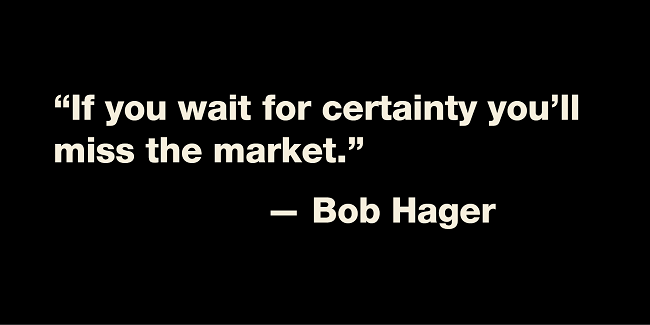
by Tom Bradley
I saw a slide this week in an investment review that was titled, ‘What we’re watching to become more constructive on equities.’ Here’s the list of indicators this U.S.-based firm is looking at to determine when to make a higher commitment to stocks (along with explanations where necessary).
- A positive spread on the 2-to-10 year yield curve. Right now, short-term bond yields are higher than long term (negative spread). This isn’t normal, but it happens. It’s noteworthy because an inverted yield curve is always present before recessions (although not every inversion is followed by a recession).
- A decline in 5-year breakeven inflation rates. I think this refers to inflation-adjusted bonds, commonly known as real return bonds (RRBs). Built into an RRB’s yield is an assumption about future inflation. If the breakeven inflation rate is declining, it means (I think) that the bond market is expecting inflation to abate.
- A decline in corporate yield spreads for both investment grade and high yield bonds. The spread, or gap, between corporate and government bond yields widens when there are concerns about the economy, which in turn can lead to increased defaults.
- A decline in the U.S. dollar index. Since early 2021, the U.S. dollar has been on a tear against all currencies (not just the Canadian dollar). This has the effect of reducing foreign profits for U.S.-based companies.
- A decline in the VIX. The VIX is a measure of how volatile the stock market is at any point in time. When stocks are bouncing around and the perceived risks are higher, the VIX tends to be higher.
- Cooler inflation readings.
- A ceasefire in Ukraine.
- Significant easing of U.S. regulations on the fossil fuel industry.
When I saw this list, I couldn’t help but think of something the late Bob Hager used to say. “If you wait for certainty you’ll miss the market.”
At Steadyhand, we’re also watching these factors, but as regular readers know, we never profess to know where the market is going in the short to medium term. Indeed, we don’t have a clue and neither does this firm, or anyone else for that matter. But we do know that Mr. Market looks ahead and tries to anticipate what is coming.
Bob refers to the fact that by the time the concerns and risks of the day are resolved, stock prices will already be significantly higher. Indeed, times of extreme pessimism and negative indicators often turn out to be good buying opportunities, as Scott pointed out in his Is it time to ‘start the car’? piece last month.
It’s our belief (Salman, our fund managers and me) that we should allocate clients’ capital to stocks that we think have an attractive long-term return based on their competitive positioning and the price we’re paying. We don’t know what road the stocks will take to achieve that return, and at the risk of sounding cavalier, we don’t spend any time trying to figure it out.
We're not a bank.
Which means we don't have to communicate like one (phew!). Sign up for our Newsletter and Blog and join the thousands of other Canadians who appreciate the straight goods on investing.

